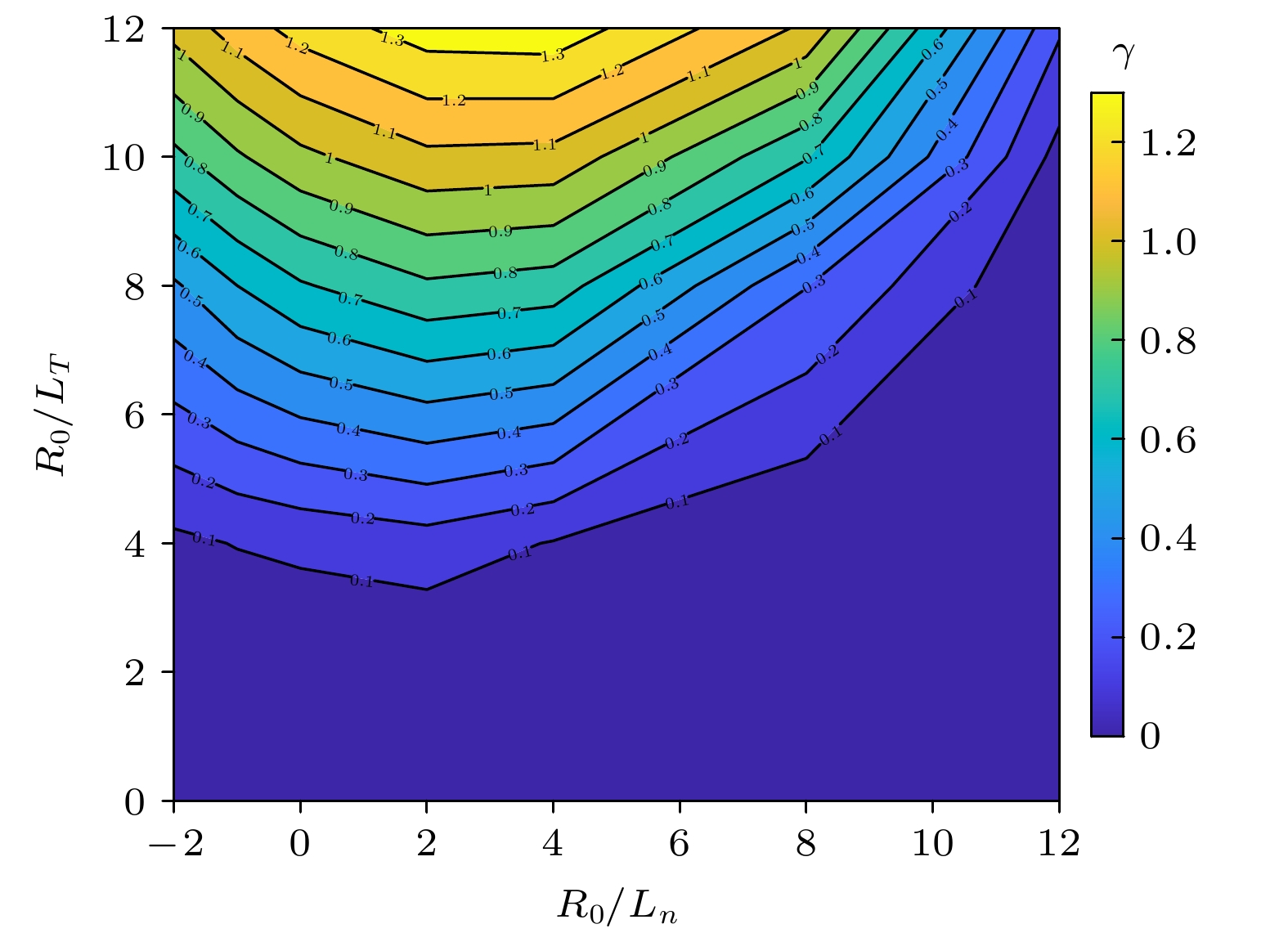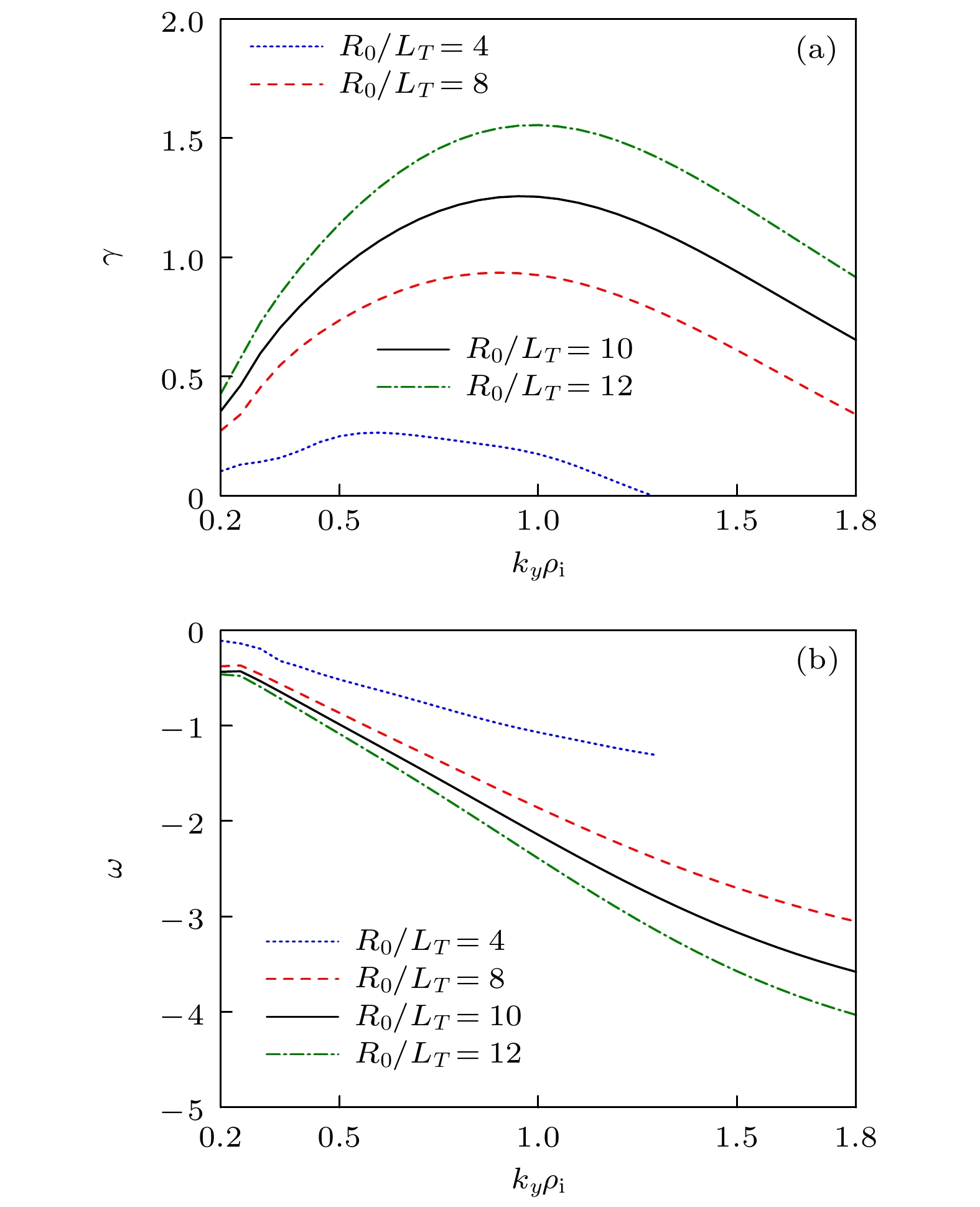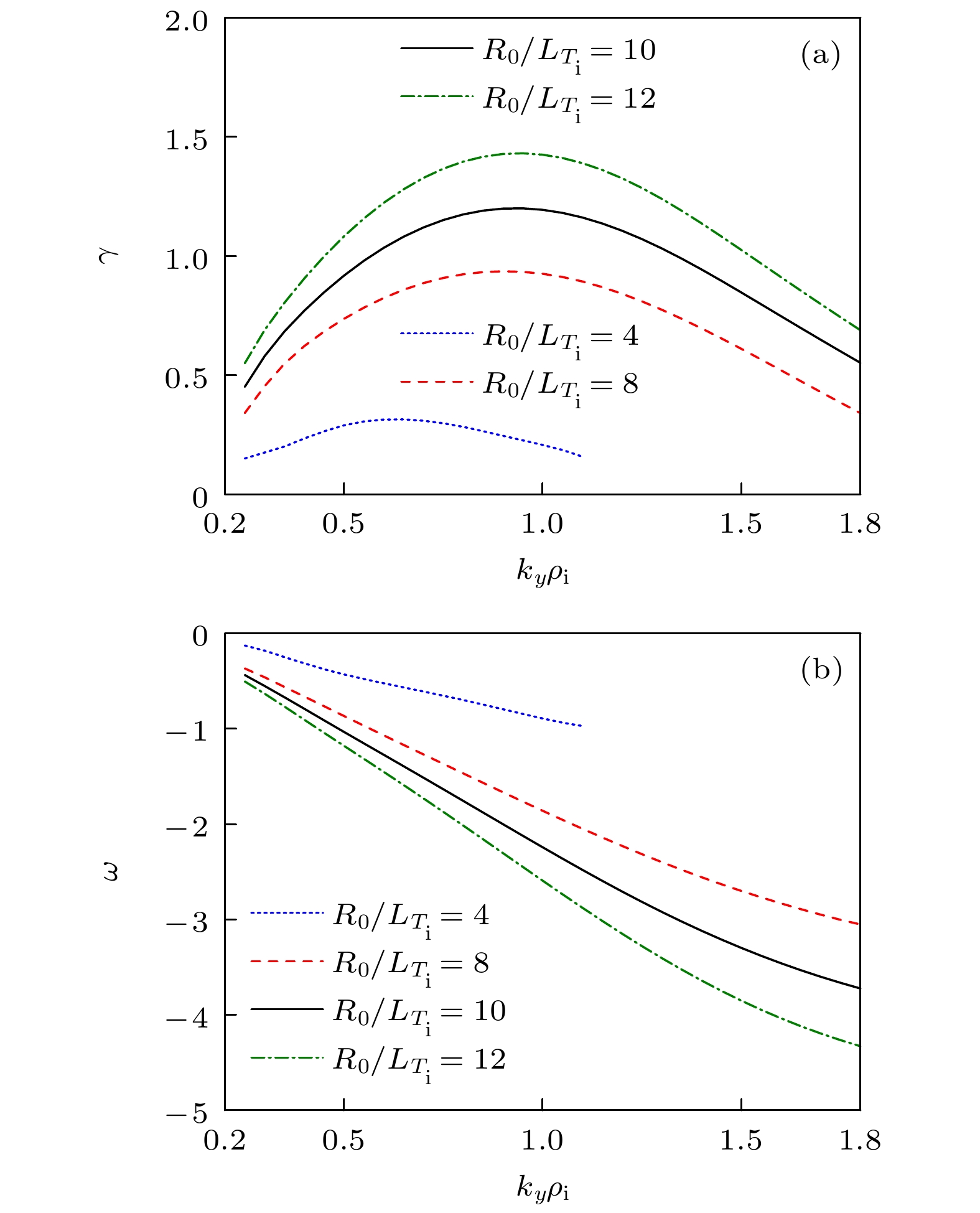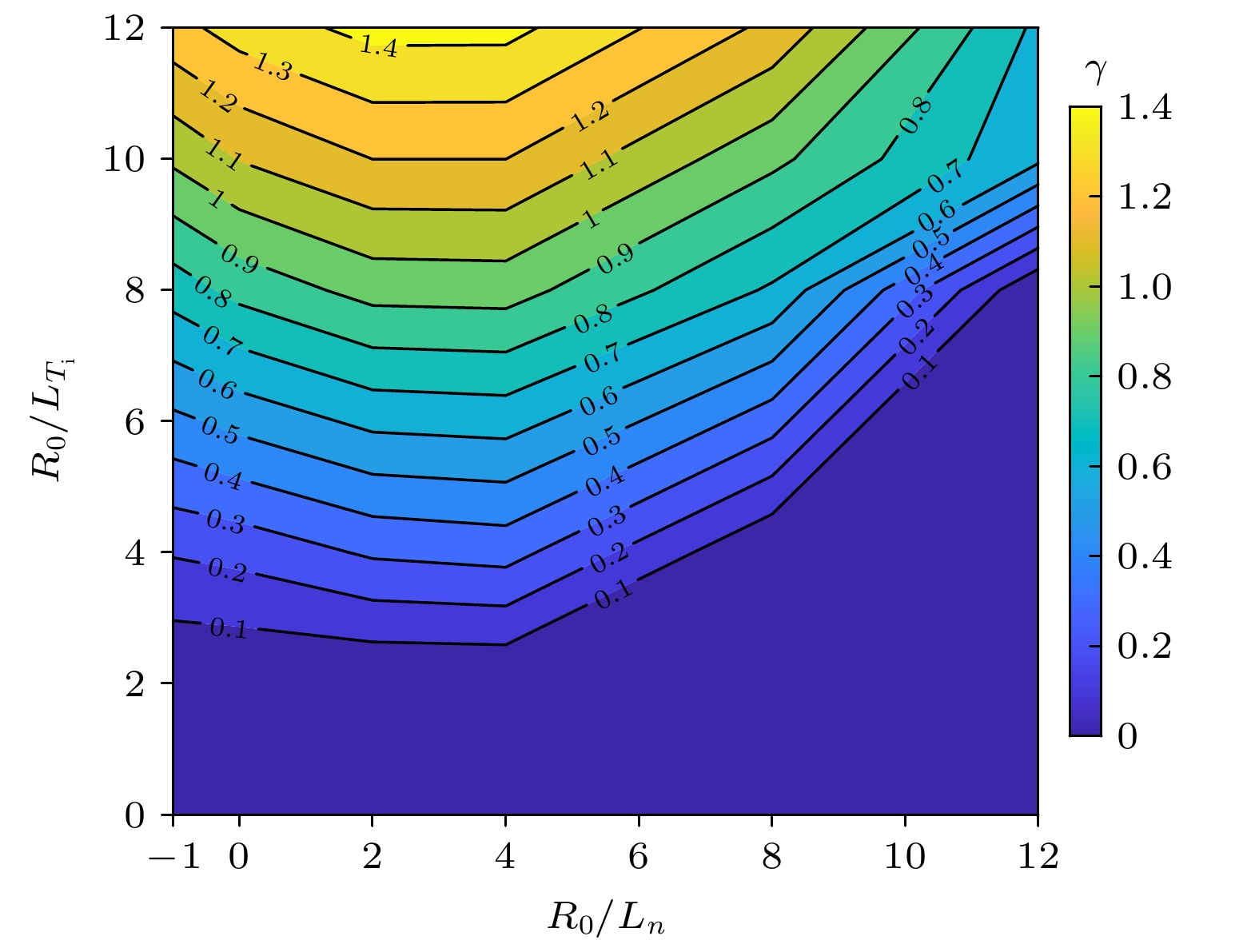-
中国首台准环对称仿星器(CFQS)是目前世界上唯一在建的准环对称仿星器. 本文利用回旋弗拉索夫代码GKV开展了CFQS中离子温度梯度模(ITG)的模拟研究. 在静电绝热条件下, 模拟的结果给出了CFQS中纯的ITG与密度梯度和温度梯度间的依赖关系. ITG的激发存在温度梯度阈值, 此温度梯度阈值受到密度梯度的影响. ITG的增长率不仅与密度梯度的绝对值相关, 还取决于密度梯度的正负, 负密度梯度对ITG具有强的抑制作用. 非绝热的模拟结果表明, 捕获电子对ITG具有去稳作用, 电子温度梯度也对ITG具有去稳作用. 当考虑电磁条件时, 有限的等离子体比压会抑制ITG, 导致ITG向阿尔芬离子温度梯度模/动理学气球模(AITG/ KBM)的转化. 当密度和温度梯度都较大时, KBM的最大增长率与密度梯度和温度梯度近似成线性关系.
-
关键词:
- 中国首台准环对称仿星器 /
- 离子温度梯度模 /
- 等离子体比压 /
- 动理学气球模
The Chinese First Quasi-axisymmetric Stellarator (CFQS) is now the only quasi-axisymmetric stellarator under construction in the world. In this work, ion temperature gradient (ITG) mode in CFQS is studied by using gyrokinetic Vlasov code GKV. The basic characteristics of the eletrtostatic ITG are separately given under the adiabatic condition and the non-adiabatic condition. There is a critical temperature gradient for ITG. The growth rate of ITG is proportional to the temperature gradient. Furthermore, the growth rate depends on not only the absolute value of density gradient, but also the plus or minus sign of the density gradient. The negative density gradient can strongly suppress the ITG. The kinetic electron can destabilize the ITG and the electron temperature gradient can also destabilize the ITG. For electromagnetic condition, the ITG modes can be suppressed by the finite plasma beta, and then a transition from ITG to Alfvenic ion temperature gradient mode/kinetic ballooning mode (AITG/KBM) comes into being. The maximum growth rate of KBM is linearly proportional to density gradient and temperature gradient when both gradients are large.-
Keywords:
- Chinese First Quasi-axisymmetric Stellarator /
- ion temperature gradient mode /
- plasma beta /
- kinetic ballooning mode
[1] Xu Y 2016 Matter Radiat. Extremes 1 192
 Google Scholar
Google Scholar
[2] Ho D D M 1987 Phys. Fluids 30 442
 Google Scholar
Google Scholar
[3] Boozer A H 1995 Plasma Phys. Controlled Fusion 37 A103
 Google Scholar
Google Scholar
[4] Subbotin A A, Mikhailov M I, Shafranov V D, Isaev M Yu, Nührenberg C, Nührenberg J, Zille R, Nemov V V, Kasilov SV, Kalyuzhnyj V N 2006 Nucl. Fusion 46 921
 Google Scholar
Google Scholar
[5] Garabedian P 1996 Phys. Plasmas 3 2483
 Google Scholar
Google Scholar
[6] Shimizu A, Liu H F, Isobe M, Okamura S, Nishimura S, Suzuki C, Xu Y, Zhang X, Liu B, Huang J, Wang X Q, Liu H, Tang C J, CFQS team 2018 Plasma Fusion Res. 13 3403123
 Google Scholar
Google Scholar
[7] Zarnstorff M C, Berry L A, Brooks A, Fredrickson1 E, Fu G Y, Hirshman S, Hudson, Ku L P, Lazarus E, Mikkelsen D, Monticello D, Neilson G H, Pomphrey N, Reiman A, Spong D, Strickler D, Boozer A, Cooper W A, Goldston R, Hatcher R, Isaev M, Kessel C, Ewandowski J L, Lyon J F, Merkel P, Mynick H, Nelson B E, Nuehrenberg C, Redi M, Reiersen W, Rutherford P, Sanchez R, Schmidt J, White R B 2001 Plasma Phys. Controlled Fusion 43 A237
 Google Scholar
Google Scholar
[8] Okamura S, Matsuoka K, Nishimura S, Isobe M, Nomura I, Suzuki C, Shimizu A, Murakami S, Nakajima N, Yokoyama M 2001 Nucl. Fusion 41 1865
 Google Scholar
Google Scholar
[9] Liu H F, Shimizu A, Isobe M, Okamura S, Nishimura S, Suzuki C, Xu Y, Zhang X, Liu B, Huang J, Wang X Q, Liu H, Tang C J, Yin D P, Wan Y, CFQS team 2018 Plasma Fusion Res. 13 3405067
 Google Scholar
Google Scholar
[10] Isobe M, Shimizu A, Liu H F, Liu H, Xiong G Z, Yin D P, Ogawa K, Yoshimura Y, Nakata M, Kinoshita S, Okamura S, tang C J, Xu Y, CFQS Team 2019 Plasma Fusion Res. 14 3402074
 Google Scholar
Google Scholar
[11] Liu H F, Shimizu A, Xu Y, Okamura S, Kinoshita S, Isobe M, Li Y B, Xiong G Z, Wang X Q, Huang J, Cheng J, Liu H, Zhang X, Yin D P, Wang Y, Murase T, Nakagawa S, Tang C J 2021 Nucl. Fusion 61 016014
 Google Scholar
Google Scholar
[12] Wang X Q, Xu Y, Shimizu A, Isobe M, Okamura S, Todo Y, Wang H, Liu H F, Huang J, Zhang X, Liu H, Cheng J, Tang C J, CFQS team 2021 Nucl. Fusion 61 036021
 Google Scholar
Google Scholar
[13] Horton W 1999 Rev. Mod. Phys. 71 735
 Google Scholar
Google Scholar
[14] Watanabe T H, Sugama H 2006 Nucl. Fusion 46 24
 Google Scholar
Google Scholar
[15] Nakata M, Nunami M, Sugama H 2017 Phys. Rev. Lett. 118 165002
 Google Scholar
Google Scholar
[16] Antonsen T M, Lane B 1980 Phys. Fluids 23 1205
 Google Scholar
Google Scholar
[17] Nakata M, Honda M, Yoshida M, Urano H, Nunami M, Maeyama S, Watanabe T H, Sugama H 2016 Nucl. Fusion 56 086010
 Google Scholar
Google Scholar
[18] Beer M A, Cowley S C, Hammett G W 1995 Phys. Plasmas 2 2687
 Google Scholar
Google Scholar
[19] Romanelli M, Bourdelle C, Dorland W 2004 Phys. Plasmas 11 3845
 Google Scholar
Google Scholar
[20] Du H R, Jhang H, Hahm T S, Dong J Q, Wang Z X 2017 Phys. Plasmas 24 122501
 Google Scholar
Google Scholar
[21] 沈勇, 董家齐, 徐红兵 2018 物理学报 67 195203
 Google Scholar
Google Scholar
Shen Y, Dong J Q, Xu H B 2018 Acta Phys. Sin. 67 195203
 Google Scholar
Google Scholar
[22] Baumgaertel J A, Hammett G W, Mikkelsen D R, Nunami M, Xanthopoulos P 2012 Phys. Plasmas 19 122306
 Google Scholar
Google Scholar
[23] Dominguez R R, Waltz R E 1988 Phys. Fluids 31 3147
 Google Scholar
Google Scholar
[24] Nunami M, Watanabe T H, Sugama H, Tanaka K 2011 Plasma Fusion Res. 6 1403001
 Google Scholar
Google Scholar
[25] Alcusón J A, Xanthopoulos P, Plunk G G, Helander P, Wilms F, Turkin Y, Stechow A von, Grulke O 2020 Plasma Phys. Controlled Fusion 62 035005
 Google Scholar
Google Scholar
[26] 罗一鸣, 王占辉, 陈佳乐, 吴雪科, 付彩龙, 何小雪, 刘亮, 杨曾辰, 李永高, 高金明, 杜华荣, 昆仑集成模拟设计组 2022 物理学报 71 075201
 Google Scholar
Google Scholar
Luo Y M, Wang Z H, Chen J L, Wu X K, Fu C L, He X X, Liu L, Yang Z C, Li Y G, Gao J M, Du H R, Kulun Integrated Simulation and Design Group 2022 Acta Phys. Sin. 71 075201
 Google Scholar
Google Scholar
[27] Mahmood M A, Rafiq T, Persson M, Weiland J 2009 Phys. Plasmas 16 022503
 Google Scholar
Google Scholar
[28] Dong J Q, Mahajan S M, Horton W 1997 Phys. Plasmas 4 755
 Google Scholar
Google Scholar
[29] Peeters A G, Angioni C, Apostoliceanu M, Jenko F, Ryter F, the ASDEX Upgrade team 2005 Phys. Plasmas 12 022505
 Google Scholar
Google Scholar
[30] Sandberg I, Isliker H, Pavlenko V P 2007 Phys. Plasmas 14 092504
 Google Scholar
Google Scholar
[31] Qi L, Kwon J, Hahm T S, Jo G 2016 Phys. Plasmas 23 062513
 Google Scholar
Google Scholar
[32] Malinov P, Zonca F 2005 J. Plasma Phys. 71 301
 Google Scholar
Google Scholar
[33] Kim J Y, Han H S 2017 Phys. Plasmas 24 072501
 Google Scholar
Google Scholar
[34] Pueschel M J, Jenko F 2010 Phys. Plasmas 17 062307
 Google Scholar
Google Scholar
[35] Xie H S, Lu Z X, Li B 2018 Phys. Plasmas 25 072106
 Google Scholar
Google Scholar
[36] Aleynikova K, Zocco A 2017 Phys. Plasmas 24 092106
 Google Scholar
Google Scholar
[37] Turnbull A D, Strait E J, Heidbrink W W, Chu M S, Duong H H, Greene J M, Lao L L, Taylor T S, Thompson S J 1993 Phys. Fluids B 5 2546
 Google Scholar
Google Scholar
[38] Dong J, Chen L, Zonca F 1999 Nucl. Fusion 39 1041
 Google Scholar
Google Scholar
[39] 谢华生 2015 博士学位论文 (杭州: 浙江大学)
Xie H S 2015 Ph. D. Dissertation (Hangzhou: Zhejiang University) (in Chinese)
[40] Aleynikova K, Zocco1 A, Xanthopoulos1 P, Helander1 P, Nührenberg C 2018 J. Plasma Phys. 84 745840602
 Google Scholar
Google Scholar
-
图 4 考虑捕获电子效应后ITG的增长率(a)和频率(b)波数谱, 其中
$ {R}_{0}/{L}_{n}=2 $ , 电子温度梯度标长和离子温度梯度标长相等, 即$ {R}_{0}/{L}_{{T}_{\mathrm{e}}}={R}_{0}/{L}_{{T}_{\mathrm{i}}} $ Fig. 4. Growth rate (a) and real frequency spectra (b) of kinetic ITG for
$ {R}_{0}/{L}_{n}=2 $ . Here,$ {R}_{0}/{L}_{{T}_{\mathrm{e}}}={R}_{0}/{L}_{{T}_{\mathrm{i}}} $ .图 5 考虑捕获电子效应后ITG/TE-ITG最大增长率与密度梯度和温度梯度的关系, 其中
$ {R}_{0}/{L}_{{T}_{\mathrm{e}}}={R}_{0}/{L}_{{T}_{\mathrm{i}}} $ Fig. 5. Contour map of the maximum growth rate of kinetic ITG/TE-ITG mode vs.
$ {R}_{0}/{L}_{n} $ and$ {R}_{0}/{L}_{T} $ . Here,${R}_{0}/ {L}_{{T}_{\mathrm{e}}} $ $ ={R}_{0}/{L}_{{T}_{\mathrm{i}}}$ .图 8 当波数
$ {k}_{y}{\rho }_{\mathrm{i}}=1.0 $ 时增长率(a)与频率(b)随比压的变化(其中,$ {R}_{0}/{L}_{n}=2 $ ,$ {R}_{0}/{L}_{{T}_{\mathrm{e}}}={R}_{0}/{L}_{{T}_{\mathrm{i}}}=8 $ ), 图(a)中的箭头是从ITG转变为KBM的转变点Fig. 8. Growth rates (a) and real frequencies (b) vs.
$ \beta $ for$ {R}_{0}/{L}_{n}=2 $ and$ {R}_{0}/{L}_{{T}_{\mathrm{i}}}={R}_{0}/{{L}}_{{{T}}_{\mathrm{e}}}=8 $ at$ {k}_{y}{\rho }_{\mathrm{i}}=1.0 $ . The arrow is plotted in panel (a) to point the transition point from ITG to KBM. -
[1] Xu Y 2016 Matter Radiat. Extremes 1 192
 Google Scholar
Google Scholar
[2] Ho D D M 1987 Phys. Fluids 30 442
 Google Scholar
Google Scholar
[3] Boozer A H 1995 Plasma Phys. Controlled Fusion 37 A103
 Google Scholar
Google Scholar
[4] Subbotin A A, Mikhailov M I, Shafranov V D, Isaev M Yu, Nührenberg C, Nührenberg J, Zille R, Nemov V V, Kasilov SV, Kalyuzhnyj V N 2006 Nucl. Fusion 46 921
 Google Scholar
Google Scholar
[5] Garabedian P 1996 Phys. Plasmas 3 2483
 Google Scholar
Google Scholar
[6] Shimizu A, Liu H F, Isobe M, Okamura S, Nishimura S, Suzuki C, Xu Y, Zhang X, Liu B, Huang J, Wang X Q, Liu H, Tang C J, CFQS team 2018 Plasma Fusion Res. 13 3403123
 Google Scholar
Google Scholar
[7] Zarnstorff M C, Berry L A, Brooks A, Fredrickson1 E, Fu G Y, Hirshman S, Hudson, Ku L P, Lazarus E, Mikkelsen D, Monticello D, Neilson G H, Pomphrey N, Reiman A, Spong D, Strickler D, Boozer A, Cooper W A, Goldston R, Hatcher R, Isaev M, Kessel C, Ewandowski J L, Lyon J F, Merkel P, Mynick H, Nelson B E, Nuehrenberg C, Redi M, Reiersen W, Rutherford P, Sanchez R, Schmidt J, White R B 2001 Plasma Phys. Controlled Fusion 43 A237
 Google Scholar
Google Scholar
[8] Okamura S, Matsuoka K, Nishimura S, Isobe M, Nomura I, Suzuki C, Shimizu A, Murakami S, Nakajima N, Yokoyama M 2001 Nucl. Fusion 41 1865
 Google Scholar
Google Scholar
[9] Liu H F, Shimizu A, Isobe M, Okamura S, Nishimura S, Suzuki C, Xu Y, Zhang X, Liu B, Huang J, Wang X Q, Liu H, Tang C J, Yin D P, Wan Y, CFQS team 2018 Plasma Fusion Res. 13 3405067
 Google Scholar
Google Scholar
[10] Isobe M, Shimizu A, Liu H F, Liu H, Xiong G Z, Yin D P, Ogawa K, Yoshimura Y, Nakata M, Kinoshita S, Okamura S, tang C J, Xu Y, CFQS Team 2019 Plasma Fusion Res. 14 3402074
 Google Scholar
Google Scholar
[11] Liu H F, Shimizu A, Xu Y, Okamura S, Kinoshita S, Isobe M, Li Y B, Xiong G Z, Wang X Q, Huang J, Cheng J, Liu H, Zhang X, Yin D P, Wang Y, Murase T, Nakagawa S, Tang C J 2021 Nucl. Fusion 61 016014
 Google Scholar
Google Scholar
[12] Wang X Q, Xu Y, Shimizu A, Isobe M, Okamura S, Todo Y, Wang H, Liu H F, Huang J, Zhang X, Liu H, Cheng J, Tang C J, CFQS team 2021 Nucl. Fusion 61 036021
 Google Scholar
Google Scholar
[13] Horton W 1999 Rev. Mod. Phys. 71 735
 Google Scholar
Google Scholar
[14] Watanabe T H, Sugama H 2006 Nucl. Fusion 46 24
 Google Scholar
Google Scholar
[15] Nakata M, Nunami M, Sugama H 2017 Phys. Rev. Lett. 118 165002
 Google Scholar
Google Scholar
[16] Antonsen T M, Lane B 1980 Phys. Fluids 23 1205
 Google Scholar
Google Scholar
[17] Nakata M, Honda M, Yoshida M, Urano H, Nunami M, Maeyama S, Watanabe T H, Sugama H 2016 Nucl. Fusion 56 086010
 Google Scholar
Google Scholar
[18] Beer M A, Cowley S C, Hammett G W 1995 Phys. Plasmas 2 2687
 Google Scholar
Google Scholar
[19] Romanelli M, Bourdelle C, Dorland W 2004 Phys. Plasmas 11 3845
 Google Scholar
Google Scholar
[20] Du H R, Jhang H, Hahm T S, Dong J Q, Wang Z X 2017 Phys. Plasmas 24 122501
 Google Scholar
Google Scholar
[21] 沈勇, 董家齐, 徐红兵 2018 物理学报 67 195203
 Google Scholar
Google Scholar
Shen Y, Dong J Q, Xu H B 2018 Acta Phys. Sin. 67 195203
 Google Scholar
Google Scholar
[22] Baumgaertel J A, Hammett G W, Mikkelsen D R, Nunami M, Xanthopoulos P 2012 Phys. Plasmas 19 122306
 Google Scholar
Google Scholar
[23] Dominguez R R, Waltz R E 1988 Phys. Fluids 31 3147
 Google Scholar
Google Scholar
[24] Nunami M, Watanabe T H, Sugama H, Tanaka K 2011 Plasma Fusion Res. 6 1403001
 Google Scholar
Google Scholar
[25] Alcusón J A, Xanthopoulos P, Plunk G G, Helander P, Wilms F, Turkin Y, Stechow A von, Grulke O 2020 Plasma Phys. Controlled Fusion 62 035005
 Google Scholar
Google Scholar
[26] 罗一鸣, 王占辉, 陈佳乐, 吴雪科, 付彩龙, 何小雪, 刘亮, 杨曾辰, 李永高, 高金明, 杜华荣, 昆仑集成模拟设计组 2022 物理学报 71 075201
 Google Scholar
Google Scholar
Luo Y M, Wang Z H, Chen J L, Wu X K, Fu C L, He X X, Liu L, Yang Z C, Li Y G, Gao J M, Du H R, Kulun Integrated Simulation and Design Group 2022 Acta Phys. Sin. 71 075201
 Google Scholar
Google Scholar
[27] Mahmood M A, Rafiq T, Persson M, Weiland J 2009 Phys. Plasmas 16 022503
 Google Scholar
Google Scholar
[28] Dong J Q, Mahajan S M, Horton W 1997 Phys. Plasmas 4 755
 Google Scholar
Google Scholar
[29] Peeters A G, Angioni C, Apostoliceanu M, Jenko F, Ryter F, the ASDEX Upgrade team 2005 Phys. Plasmas 12 022505
 Google Scholar
Google Scholar
[30] Sandberg I, Isliker H, Pavlenko V P 2007 Phys. Plasmas 14 092504
 Google Scholar
Google Scholar
[31] Qi L, Kwon J, Hahm T S, Jo G 2016 Phys. Plasmas 23 062513
 Google Scholar
Google Scholar
[32] Malinov P, Zonca F 2005 J. Plasma Phys. 71 301
 Google Scholar
Google Scholar
[33] Kim J Y, Han H S 2017 Phys. Plasmas 24 072501
 Google Scholar
Google Scholar
[34] Pueschel M J, Jenko F 2010 Phys. Plasmas 17 062307
 Google Scholar
Google Scholar
[35] Xie H S, Lu Z X, Li B 2018 Phys. Plasmas 25 072106
 Google Scholar
Google Scholar
[36] Aleynikova K, Zocco A 2017 Phys. Plasmas 24 092106
 Google Scholar
Google Scholar
[37] Turnbull A D, Strait E J, Heidbrink W W, Chu M S, Duong H H, Greene J M, Lao L L, Taylor T S, Thompson S J 1993 Phys. Fluids B 5 2546
 Google Scholar
Google Scholar
[38] Dong J, Chen L, Zonca F 1999 Nucl. Fusion 39 1041
 Google Scholar
Google Scholar
[39] 谢华生 2015 博士学位论文 (杭州: 浙江大学)
Xie H S 2015 Ph. D. Dissertation (Hangzhou: Zhejiang University) (in Chinese)
[40] Aleynikova K, Zocco1 A, Xanthopoulos1 P, Helander1 P, Nührenberg C 2018 J. Plasma Phys. 84 745840602
 Google Scholar
Google Scholar
计量
- 文章访问数: 9859
- PDF下载量: 127
- 被引次数: 0




















 下载:
下载:






















































